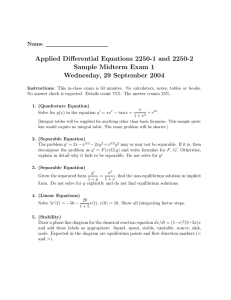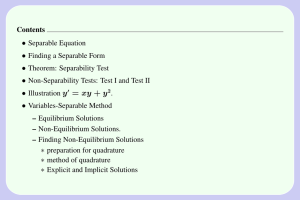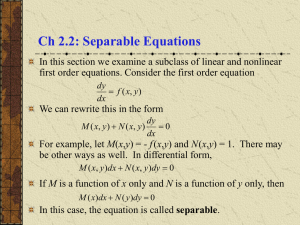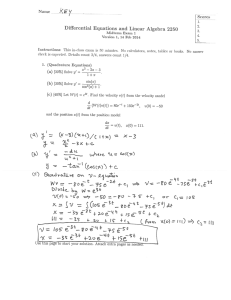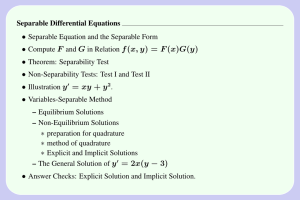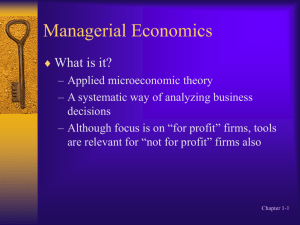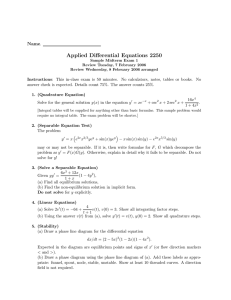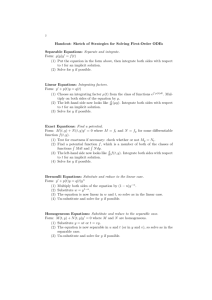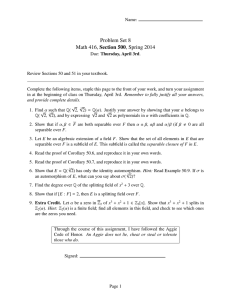Finding a Separable Form
advertisement
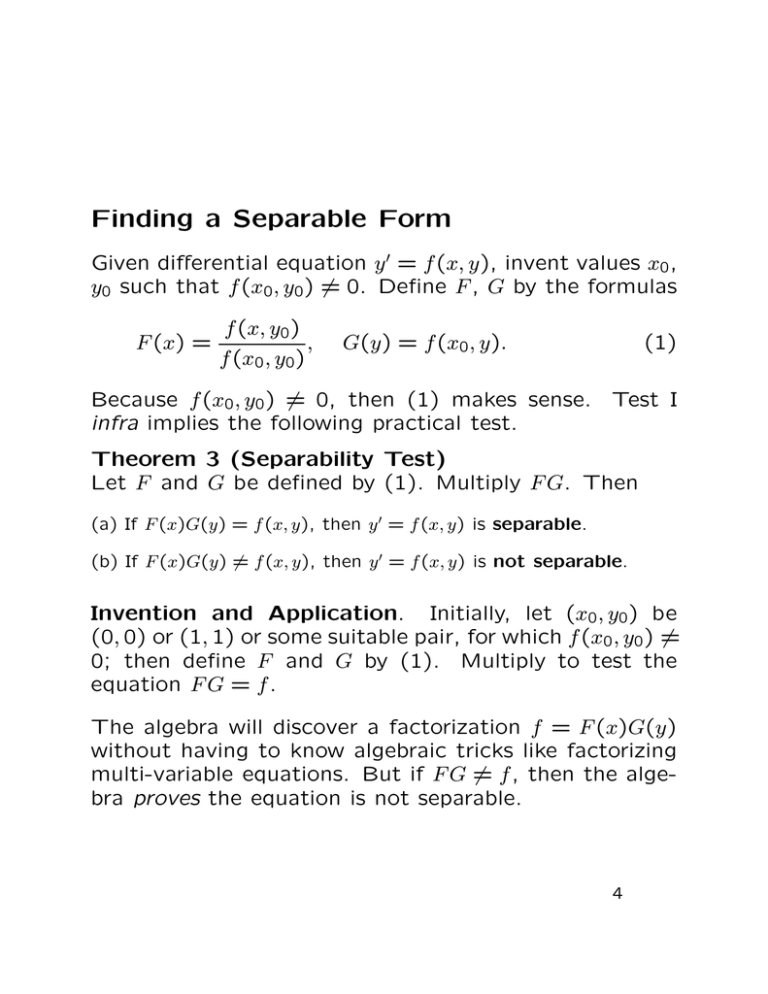
Finding a Separable Form Given differential equation y ′ = f (x, y), invent values x0 , y0 such that f (x0 , y0 ) 6= 0. Define F , G by the formulas F (x) = f (x, y0 ) , f (x0 , y0) G(y) = f (x0 , y). (1) Because f (x0 , y0 ) 6= 0, then (1) makes sense. Test I infra implies the following practical test. Theorem 3 (Separability Test) Let F and G be defined by (1). Multiply F G. Then (a) If F (x)G(y) = f (x, y), then y ′ = f (x, y) is separable. (b) If F (x)G(y) 6= f (x, y), then y ′ = f (x, y) is not separable. Invention and Application. Initially, let (x0 , y0) be (0, 0) or (1, 1) or some suitable pair, for which f (x0 , y0 ) 6= 0; then define F and G by (1). Multiply to test the equation F G = f . The algebra will discover a factorization f = F (x)G(y) without having to know algebraic tricks like factorizing multi-variable equations. But if F G 6= f , then the algebra proves the equation is not separable. 4 Non-Separability Tests. The first test uses the relation f (x, y0)f (x0, y) − f (x0, y0)f (x, y) 6= 0. (2) Test I Equation y ′ = f (x, y) is not separable if for some pair of points (x0 , y0), (x, y) in the domain of f , (2) holds. Test II The equation y ′ = f (x, y) is not separable if either fx (x, y)/f (x, y) is non-constant in y or fy (x, y)/f (x, y) is non-constant in x. Test I details. Assume f (x, y) = F (x)G(y), then equation (2) fails because each term on the left side of (2) equals F (x)G(y0)F (x0)G(y) for all choices of (x0 , y0 ) and (x, y) (hence contradiction 0 6= 0). Test II details. Assume f (x, y) = F (x)G(y) and F , G are sufficiently differentiable. Then fx (x, y)/f (x, y) = F ′ (x)/F (x) is independent of y and fy (x, y)/f (x, y) = G′ (y)/G(y) is independent of x. 5 Illustration. Consider y ′ = xy + y 2. Test I implies it is not separable, because the left side of the relation is LHS = = = 6= f (x, 1)f (0, y) − f (0, 1)f (x, y) (x + 1)y 2 − (xy + y 2) x(y 2 − y) 0. Test II implies it is not separable, because fx 1 = f x+y is not constant as a function of y. 6 Variables-Separable Method The method determines two kinds of solution formulas. Equilibrium Solutions. They are the constant solutions y = c of y ′ = f (x, y). For any equation, find them by substituting y = c into the differential equation. Non-Equilibrium Solutions. For a separable equation y ′ = F (x)G(y), a non-equilibrium solution y is a solution with G(y) 6= 0. It is found by dividing by G(y), then applying the method of quadrature. 7 Finding Non-Equilibrium Solutions A given solution y(x) satisfying G(y(x)) 6= 0 throughout its domain of definition is called a non-equilibrium solution. Then division by G(y(x)) is allowed. The method of quadrature applies to the separated equation y ′ /G(y(x)) = F (x). Some details: Rx x0 y ′ (t)dt = G(y(t)) R y(x) y0 Rx x0 F (t)dt Rx du = x F (t)dt 0 G(u) y(x) = W −1 Rx x0 F (t)dt Integrate both sides of the separated equation over x0 ≤ t ≤ x. Apply on the left the change of variables u = y(t). Define y0 = y(x0). Ry Define W (y) = y du/G(u). Take 0 inverses to isolate y(x). In practise, the last step with W −1 is never done. The preceding formula is called the implicit solution. Some work is done to find algebraically an explicit solution, as is given by W −1. 8 Explicit and Implicit Solutions Definition 2 (Explicit Solution) A solution of y ′ = f (x, y) is called explicit provided it is given by an equation y = an expression independent of y. To elaborate, on the left side must appear exactly the symbol y followed by an equal sign. Symbols y and = are followed by an expression which does not contain the symbol y. Definition 3 (Implicit Solution) A solution of y ′ = f (x, y) is called implicit provided it is not explicit. The variables-separable method gives equilibrium solutions y = c, which are already explicit. Equations like 2y = x are not explicit (they are called implicit) because the coefficient of y on the left is not 1. Similarly, y = x + y 2 is not explicit because the right side contains symbol y. Equation y = eπ is explicit because the right side fails to contain symbol y (symbol x may be absent). Applications can leave the non-equilibrium solutions in implicit form Rx R y(x) du/G(u) = x F (t)dt, with serious effort being expended to do y0 0 the indicated integrations. 9
